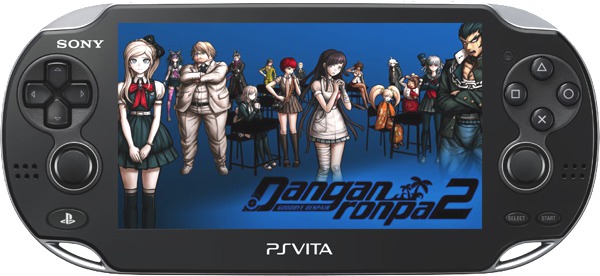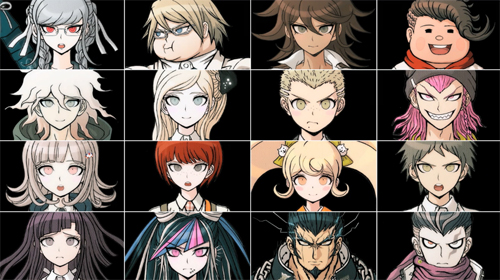 The original Danganronpa was published by NIS America and originally released here in North America on February 11, 2014. It is easily one of my favorite games of the year (Check out my review here). Shortly after its release, it was announced that its sequel would be coming out a short seven months later.
The original Danganronpa was published by NIS America and originally released here in North America on February 11, 2014. It is easily one of my favorite games of the year (Check out my review here). Shortly after its release, it was announced that its sequel would be coming out a short seven months later.
Just like the original game,  Danganronpa 2: Goodbye Despair is a visual novel with a murder mystery twist. Unlike the first game where the characters are trapped in a high school, this time all of the characters (again a set of students from Hope’s Peak Academy) are trapped on the tropical Jabberwock Island. Does Danganronpa 2: Goodbye Despair live up to the high quality of the original? Keep reading to find out!
Danganronpa 2: Goodbye Despair is a visual novel with a murder mystery twist. Unlike the first game where the characters are trapped in a high school, this time all of the characters (again a set of students from Hope’s Peak Academy) are trapped on the tropical Jabberwock Island. Does Danganronpa 2: Goodbye Despair live up to the high quality of the original? Keep reading to find out!
Story
In Danganronpa 2: Goodbye Despair, the player takes control as Hajime Hinata, a student recently admitted to the highly prestigious Hope’s Peak Academy. Students are only selected for this high school if they are considered an ‘Ultimate’. Unfortunately, Hajime suffers from amnesia through the first chapter and possibly beyond (the publisher has requested that I only discuss story elements from the first chapter), so his Ultimate ability is a mystery. However, there are 15 other Ultimate students with him including the Ultimate Gamer, the Ultimate Princess, and the Ultimate Team Manager (just to name a few). Each character has a very unique personality and its easy to get engrossed in just learning about the different characters.

The game opens with Hajime arriving at Hope’s Peak Academy along with the other students. However, the scenery quickly changes as their ‘teacher,’ Usami (a pink rabbit), decides to take them on a field trip to the remote tropical resort of Jabberwock Island. Usami tasks the students to make friends and get to know each other peacefully. This seemingly innocent opening abruptly shifts as Monokuma, an evil mechanical bear who is also the ‘principal’ of Hope’s Peak Academy, appears. He quickly takes over the field trip from Usami and just like the first game informs the students that if one of them wishes to escape the island they must successfully murder another student and get away with it. Once a murder takes place, there is a Class Trial (more details below) and if the students can determine the identity of the murderer that person is executed. However, if the students choose wrong, everyone is executed except for the killer.
This game obviously have a very dark premise, but this darkness is expertly balanced with lighthearted fun and goofy situations (not to mention the occasional dose of fan service). The mysterious nature of the story is also very intriguing and I truly believe that it outshines the original game. The dialogue between characters is well written and the voice acting is superb. Having said that, a majority of the story is presented in text form only and since this game is a visual novel expect to do quite a bit of reading.
Gameplay
The game is presented mainly from a first person perspective with some of the island exploration being shown from a side view. Generally, gameplay is split into three separate sections. First is the Daily Life section where the player explores the island and deepens relationships with other classmates to unlock Hope Shards (which are used to unlocked skills to use during the Class Trial). The next section is the Deadly Life and occurs immediately following the murder of one the students. The Deadly Life phase is very similar to Daily Life, except the exploration of the island is replaced with a search for clues about the murder.
After all of the available clues have been found, Monokuma will call every student to take part in the Class Trial. In this final phase players are forced to present collected evidence, refute any misinformation presented by the other members of the class, and determine the identity of the true killer. The evidence that is collected in the Deadly Life phase takes the form of Truth Bullets/Blades which are used to literally shoot down or slice through inconsistencies in arguments or present new information. The Class Trial phase keeps most of the mechanics used in the original game while adding a few new ones as well. This leads to very high paced gameplay and is an enjoyable change of pace compared to the other phases. Class Trials can be very difficult (especially on the highest difficulty) and it requires a keen sense of observation, quick reflexes, and a solid memory. Once a Class Trial concludes, the murderer is executed in a highly stylized and unique way. The game then proceeds and the cycle of phases begin again.
Just like the original, there are several extra modes that unlock as you progress through the game. There is a virtual pet that will give you rewards if you care for it, a mode where you control Usami as she fights monsters, an Island mode (unlocked after beating the game) that allows you to deepen the relationships with the other members of the class without all of the pesky murders, and another mode revolving around the original game that is so good I don’t want to spoil it here.
Verdict
Danganronpa 2: Goodbye Despair takes all of the things that made the original great and takes them to the next level. The story is thrilling and the gameplay can be downright addicting. As someone who loves in depth stories in my games, I simply cannot get enough of the Danganronpa franchise. If you have not played the first game I highly recommend you start there (it’s currently on sale on PSN). However, anyone who likes a deep and engrossing story truly owes it to themselves to play this game.
Recommendation Level: High!!
*Danganronpa 2: Goodbye Despair will be released for the PlayStation Vita in North America on September 2nd and in Europe on September 5th. It will be available digitally on the PlayStation Store and at retail for $39.99. A copy of the game was provided by the publisher for review.
Discuss:
Will you be purchasing Danganronpa 2: Goodbye Despair? Did you play the first game, Danganronpa: Trigger Happy Havoc?

You must be logged in to post a comment.